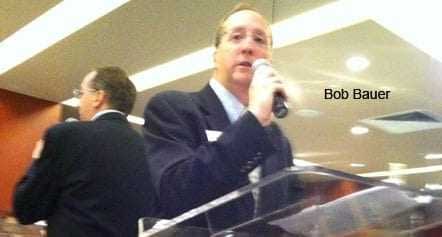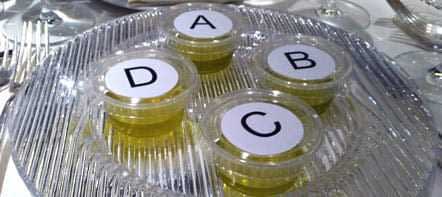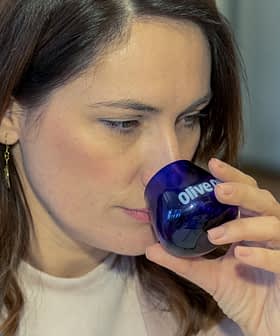Olive oil industry executives and journalists gathered at a Midtown Manhattan Italian restaurant Monday evening for an olive oil tasting and dinner hosted by the North American Olive Oil Association.

Stephen Mandia, chairman of the trade group, which is affiliated with the International Olive Council (IOC), welcomed guests to the event titled “Pour on the Flavor.” Mandia, 45, founded a privately-held company East Coast Olive Oil Corporation in 1991 which became the largest importer of olive oil in the United States. Eighty percent of the company was sold to Nutrinveste of Portugal. Mandia continues to serve as chairman of the board of directors of the company, now called Sovena USA.
Bob Bauer, executive director of the NAOOA, introduced the trade association, which is comprised of major importers and the American subsidiaries of the world’s largest olive oil companies. He began by describing the International Olive Council’s function as the world body that determines standards and ensures olive oil quality. “We work closely with the IOC,” he said, adding “the NAOOA is a de facto certification program,” since companies that do not comply with IOC standards cannot maintain membership in the group nor bear the NAOOA seal.

The featured speaker was Dr. Wencesloa Moreda, a research scientist at the Instituto de la Grasa of the Spanish Research Council who presented a basic introduction to olive oil.
The disparate group of attendees ranged from senior executives of the world’s largest olive oil companies including Grupo Sos, Filipo Berio, Pompeian and Sovena Group to food writers and other journalists, many of whom seemed to be tasting olive oil, by itself, for the first time.
Consequently reactions to sipping straight olive oil ranged from knowing nods by the olive oil pros, to winces by some of the New York area writers unaccustomed to olive oil tastings.

The first oil was moderately fruity, with a slightly greasy feel and the taste of almond. Next was an oil with greener notes, more bitter, but with a less pungent finish. Participants marveled how the third oil displayed no aroma at all, and almost no taste. It was explained this was a light olive oil suitable for cooking and frying. Finally, when the plastic lid was lifted from the fourth olive oil the scent was of sparkling wine, and the taste was off. This was an oil displaying a number of defects, the presenter explained, including rancidity.

Executive chef Matteo Bergamini of SD26, the restaurant formerly well-known as San Domenico on Central Park South, presented the evening’s menu which he paired with the featured olive oils, which were not named. He used the medium-intense oil on a quail egg salad, the more peppery extra virgin for a risotto with mussels and squid. A shoulder of beef was dressed with another olive oil that was not included in the tasting. The dinner was nicely presented and delicious.
There were no questions asked during the presentation, although some of the olive oil executives were available to reporters beforehand. Dinner conversation spanned a variety of topics including olive oil quality issues, prices in Europe, New World production and marketing challenges.
Several executives were encouraged by the campaign to promote olive oil use in North America recently announced by IOC Director Jean-Louis Barjol and scheduled to launch at this Summer’s Fancy Food Show in Washington.
There was an olive oil “tasting bar” that looked like it could have been transplanted from any supermarket. The brands on display and available for tasting included Goya, Carapelli, Star, Carbonell, Pompeian, Filippo Berio and Zoe.




